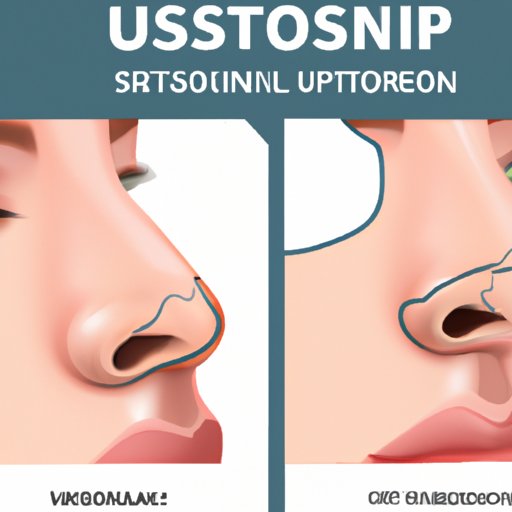
I. Introduction
Deviated septum is a condition that affects the structure and function of the nose. It occurs when the nasal septum, which divides the nostrils, is significantly displaced to one side. While it’s a common condition that affects a large number of people, there are still many misconceptions and uncertainties surrounding it. Understanding how a deviated septum occurs, its common causes, symptoms, and treatment options can help individuals seek appropriate medical attention, alleviate symptoms, and ensure better quality of life.
II. Understanding the Anatomy
To understand how a deviated septum occurs, it’s essential to know the basic anatomy of the nose. The nose is made up of two nasal cavities, each with a narrow pathway that leads to the nostrils. The nasal septum is a thin wall of bone and cartilage that separates the nasal cavities and extends from the front of the nose to the back of the throat. Its role is to support the nose and regulate air flow into and out of the respiratory system.
A deviated septum occurs when the nasal septum is displaced or shifted to one side, creating an imbalance in the nasal passage. This can be caused by several factors, including trauma, congenital abnormalities, and aging. A deviated septum can also be described as being either partial or complete, depending on how much it is shifted from the central position.
III. Common Causes
Deviated septum can be caused by different factors, but the most common include:
Trauma:
Any trauma or injury to the nose, such as a broken nose, can cause a deviated septum. The degree of displacement depends on the severity of the injury and the type of tissue that’s affected. Trauma can also result in other nasal complications, such as sinusitis, rhinitis, and nosebleeds.
Congenital abnormalities:
Some people are born with a deviated septum due to genetic predisposition or fetal development issues. This type of deviation is usually evident from an early age, but symptoms may worsen over time.
Aging:
As we age, the tissues and bones in the nose can change, leading to a deviated septum. This is why some people may experience deviated septum symptoms later in life, even though they didn’t have any before.
Other potential causes:
Other potential causes of a deviated septum include hormonal changes, such as those experienced during pregnancy, and inflammation or infection of the nasal passages.
IV. Symptoms and Diagnosis
Deviated septum symptoms can vary from person to person, but common indicators include:
- Nasal congestion in one side
- Nasal obstruction
- Frequent nosebleeds
- Sinus infections
- Headaches
- Facial pain
- Loud breathing
- Snoring or sleep apnea
- Difficulty breathing during exercise
Doctors can diagnose a deviated septum through physical examination and several tests, including:
- Rhinometry: to measure air flow and resistance through the nose
- Nasal endoscopy: to check for nasal anomalies, such as polyps and inflammation
- Computed tomography (CT) scan: to get a detailed image of the nasal structure
V. Treatment Options
There are different treatment options for a deviated septum, depending on the severity of the deviation and how it affects the patient’s overall health. Some of the most common treatments include:
Medication:
Medication can be prescribed to alleviate symptoms such as nasal congestion, inflammation, and pain. Nasal sprays, antihistamines, and decongestants are some of the most commonly used medications. However, medication cannot fix a deviated septum or improve nasal function.
Therapy:
Nasal therapy can help improve nasal function and reduce symptoms. Different nasal therapy options include nasal dilators, saline solution irrigation, and nasal septal buttons. These options can help improve breathing and reduce the risk of respiratory infections.
Surgery:
Surgery is the most effective way to correct a deviated septum. The type of surgery depends on the severity of the deviation and the patient’s overall health. Some of the most common surgical options include septoplasty, submucosal resection, and septorhinoplasty. Surgery is usually performed under general anesthesia and can take several weeks to recover.
VI. Personal Stories
Many people have successfully dealt with a deviated septum and shared their experiences. Their stories can help those who are currently experiencing deviated septum symptoms or considering treatment options. Recommendations include:
- Communicate with your doctor about any concerns or questions you may have.
- Research your treatment options and find a qualified professional to perform the procedure.
- Follow post-surgery instructions carefully and take time to rest and recover.
VII. Conclusion
Deviated septum is a common but treatable condition that affects many people. Understanding its causes, symptoms, and treatment options can help improve overall health and quality of life. Seeking medical attention and following the advice of a qualified healthcare professional can help alleviate symptoms and prevent complications.





